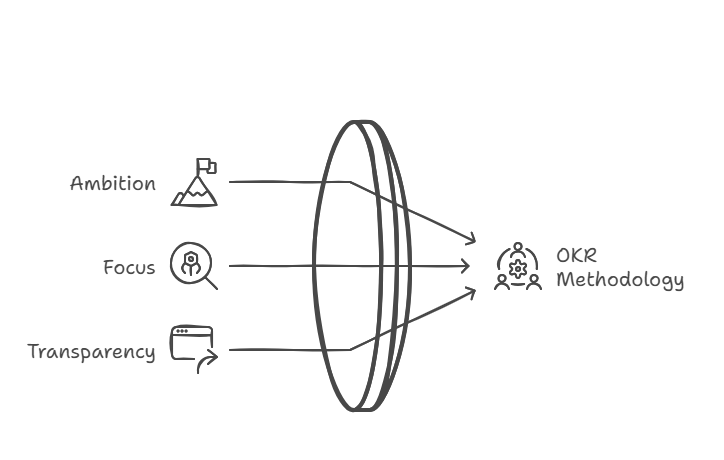Introduction
In today’s fast-paced business world, organizations need a clear, adaptable framework to set goals, track progress, and drive results. Enter OKR, or Objectives and Key Results—a goal-setting methodology that has powered giants like Google, Intel, and LinkedIn to achieve ambitious outcomes. But what exactly is OKR? How does it work in practice? And why has it become a cornerstone of modern business strategy?
This article breaks down the meaning of OKR, its applications across industries, and how it complements methodologies like Agile and tools like KPIs. Whether you’re a startup founder, a marketing leader, or an Agile team member, you’ll learn how to harness OKRs to align your team and supercharge productivity.
Table of Contents
What is OKR? Breaking Down the Basics
OKR Full Meaning
OKR stands for Objectives and Key Results. It’s a goal-setting framework that helps organizations define what they want to achieve (Objectives) and how they’ll measure success (Key Results).
- Objective: A qualitative, aspirational goal. Example: “Become the market leader in eco-friendly packaging.”
- Key Result: A quantitative metric to track progress. Example: “Increase sales of eco-friendly products by 30% in Q3.”
OKR Framework Meaning
The OKR framework creates alignment by cascading goals from company-wide objectives down to team and individual levels. For instance, if a company’s objective is to “Improve customer satisfaction,” a support team’s key result might be “Reduce average response time to 2 hours.”
OKR in Business: Driving Alignment and Results
OKR Meaning in Business
In business, OKRs bridge the gap between strategy and execution. They ensure everyone works toward the same priorities, fostering transparency and accountability.
Example:
- Company Objective: “Expand into the European market.”
- Sales Team Key Result: “Secure partnerships with 10 distributors in Germany by Q4.”
- Marketing Team Key Result: “Generate 500 qualified leads from Europe in 6 months.”

OKR in Marketing
Marketing teams use OKRs to focus on outcomes, not just activities. For example:
- Objective: “Boost brand awareness in the healthcare sector.”
- Key Result 1: “Increase website traffic from healthcare professionals by 40%.”
- Key Result 2: “Achieve 1,000 downloads of our healthcare whitepaper.”
Company OKR Case Study: Google
Google famously uses OKRs to “set impossible goals.” In 2008, their objective was “Build the next-generation client platform for web applications.” A key result? “10 million weekly Chrome users.” They hit 20 million.
OKR Software and Systems: Tools for Success
OKR Software Meaning
OKR software (like Asana, Weekdone, or BetterWorks) automates tracking, updates, and collaboration. These tools visualize progress, assign owners, and integrate with project management systems.
Example: A SaaS company uses Asana to link engineering OKRs (e.g., “Launch feature X by June”) to customer success OKRs (“Achieve 90% adoption of feature X”).
OKR System Meaning
An OKR system embeds goal-setting into an organization’s DNA. It includes:
- Quarterly Planning: Setting 3-5 objectives per team.
- Weekly Check-ins: Reviewing progress and blockers.
- Retrospectives: Analyzing what worked and what didn’t.
OKR Methodologies: Agile, KPIs, and Beyond
OKR Methodology Meaning
The OKR methodology emphasizes:
- Ambition: Objectives should stretch teams beyond their comfort zones.
- Focus: Limit to 3-5 objectives per cycle to avoid dilution.
- Transparency: All OKRs are visible company-wide.

OKR Agile Meaning
Agile teams use OKRs to align sprints with long-term goals. For example:
- Objective: “Improve user onboarding experience.”
- Sprint 1 Key Result: “Reduce signup steps from 5 to 3.”
- Sprint 2 Key Result: “Achieve 80% user completion rate.”
OKR vs. KPI: Clarifying the Difference
- KPI (Key Performance Indicator): Measures ongoing performance (e.g., “Monthly recurring revenue”).
- OKR: Drives change and innovation (e.g., “Launch a new product line to increase revenue by 15%”).
How They Work Together:
- A company might use a KPI to track current sales growth and an OKR to accelerate growth through a new market entry.
Implementing OKRs: A Step-by-Step Guide
- Define Company-Level Objectives
Example: “Become the #1 fitness app in Asia.” - Cascade to Teams
- Product Team: “Launch localized features for Japan.”
- Marketing Team: “Run 5 influencer campaigns in Southeast Asia.”
- Set Measurable Key Results
- “Acquire 100,000 new users in Japan by Q3.”
- Track Progress Weekly
Use OKR software to update results and address bottlenecks. - Review and Adapt
Reflect quarterly: “Did we hit 70% of our key results? If not, why?”
Benefits and Challenges of OKRs
Benefits
- Alignment: Everyone understands how their work contributes to company goals.
- Agility: Easily pivot when market conditions change.
- Motivation: Teams feel empowered by ambitious, measurable goals.
Common Pitfalls
- Too Many Objectives: Leads to burnout and fragmented efforts.
- Vague Key Results: Avoid phrases like “Improve customer satisfaction”—use “Increase Net Promoter Score from 30 to 45.”
- Set-and-Forget Mentality: OKRs require regular check-ins.
Conclusion
OKRs are more than a buzzword—they’re a proven system for turning vision into action. By combining aspirational objectives with measurable results, businesses can foster innovation, alignment, and accountability. Whether you’re adopting OKR software, integrating it with Agile, or differentiating it from KPIs, the key is to start small, iterate, and keep your teams focused on what truly matters.
FAQs about the meaning of OKR
What’s the full meaning of OKR?
OKR stands for Objectives and Key Results, a goal-setting framework.
How do OKRs differ from KPIs?
KPIs track ongoing performance, while OKRs drive specific, time-bound initiatives.
Can nonprofits use OKRs?
Absolutely! A nonprofit might set an objective like “Reduce homelessness in City X by 20%” with key results tied to fundraising and program reach.
How often should OKRs be reviewed?
Weekly check-ins and quarterly reviews are standard.
What’s an example of an OKR in marketing?
Objective: “Increase organic website traffic.” Key Results: “Publish 10 SEO-optimized blogs monthly” and “Grow traffic by 25% in 6 months.”
